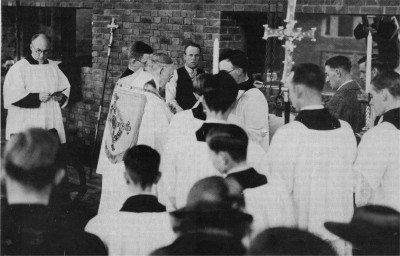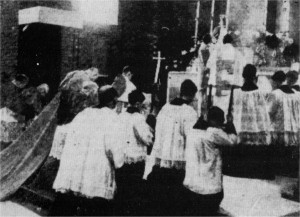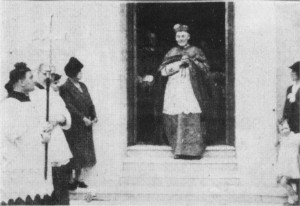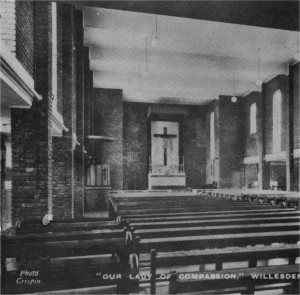
Cardinal Hinsley laid the Foundation Stone on 2nd October 1938. “After a wet morning”, wrote the Willesden Chronicle, “the weather brightened and cleared in time for the ceremony. The crowd began to gather about 3.30pm and grew quickly. Some climbed on the scaffolding and others even got on to the framework of the roof! By the time the ceremony was due to begin over a thousand had gathered…. Using an inscribed silver trowel, his Eminence performed the ceremony of laying the stone. In it he placed a scroll recording the early history of the parish…. In a short sermon the Cardinal warned his hearers that “God dwelleth not in temples that are made by hands” and urged them to remember always that the Kingdom of God was within them. During the subsequent building, a snag occurred: the concrete roof was to have been laid in one piece, but the work was interrupted by heavy rain. Certainly it was to leak in later years.
The last Mass at Linacre Road was celebrated on 7th May 1939 and the first Mass in the new church on Sunday, 8th May.

On 9th May the church, still dedicated to Our Lady of Compassion, was opened by Cardinal Hinsley. Tablets record the gift of the altar rails in memory of Fr. Fitzgerald’s mother, Caroline Amy; of the Sanctuary gates (since removed) by Fr. Fitzgerald’s father Michael Joseph; of the original altar, part of which now supports the tabernacle, in memory of Lilian Clayton and of the Lady Chapel in memory of Effie Mary Carter.
The Willesden Chronicle wrote: “The completed church is of noble and dignified proportions, with a full view of the altar and sanctuary from every angle.” The Cardinal’s own description was: a practical working church. Ten Canons were present and “about 100 clergy from the Archdiocese of Westminster, practically every parish being represented. Rev. J. Hampson, PhD of the Catholic Missionary Society, Brondesbury Park, sang the Mass. The music was beautifully sung by the choir, who comprised children of the Elementary School in Linacre Road, who had been taught the Latin and the music for months past and who rendered both without a mistake. Mother St. Ignatius, the Headmistress, was their instructress.

“Over 100 sat down to the excellent luncheon which was afterwards served in the school hall of the Convent of Jesus and Mary. Welcoming the guests Fr. Fitzgerald said: ‘He was glad to see Fr. Musgrove, who as far back as 1901 used to cycle three miles to Willesden Green to say Mass’ and Canon Browne ‘who put up with him for nine years and taught him all he knew about running a parish….’
He rejoiced to know he had some of his Anglican and Free Church colleagues present. When he came to Willesden he made up his mind that, in obedience to the Holy Father, he would seek all possible points of contact with his fellow-ministers, so that they could show a united front to resist the forces of modern unbelief. He found that desire reciprocated, and Willesden was one of the few areas which had a Ministers’ Fraternal, which represented 40 churches…. He was particularly pleased to have as his guest Rabbi Rabinowitz. He was confident that every responsible citizen of the Borough had been profoundly impressed by his dignified bearing in the face of the anti-semitic attacks against the Jews of the district….

He wanted an industrial church, one which was modern and yet ancient, beautiful, impressive and devotional. He had heard it rudely called Father Fitzgerald’s “gas works and tube station” but he had built it to accommodate 850 people at a cost of £10,600…. He paid a great tribute to 18 married women, mothers of families, who had scrubbed and polished the floors, with no other reward than the knowledge that they were honouring God’s house.
He had the utmost loyalty and support from his parishioners, the majority of whom were what were described as the working classes. The slump came, and it looked as though the scheme would fail, but by entertainments and subscriptions, over and above the ordinary maintenance, they had raised £2257 6s. ld’.”
Move to next section – The War
Return to Contents Page